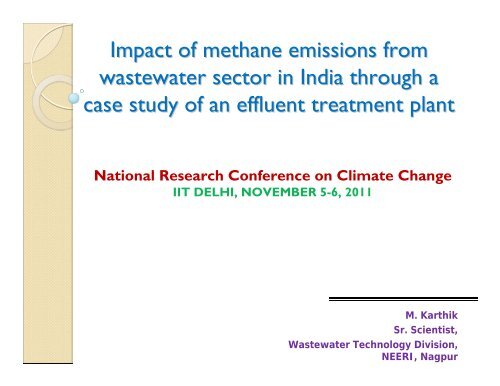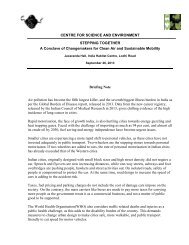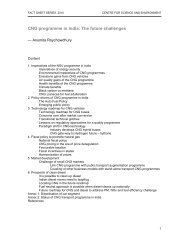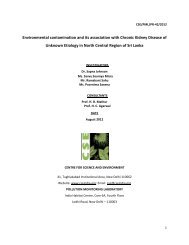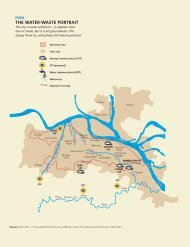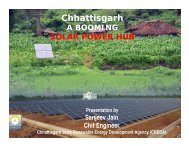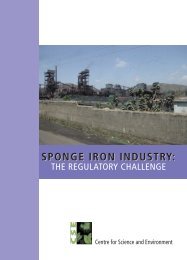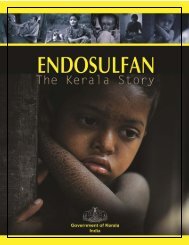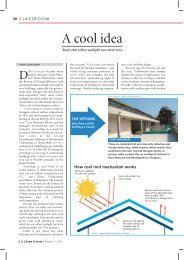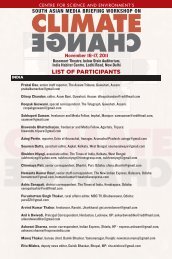Impact of methane emissions from wastewater sector in India ...
Impact of methane emissions from wastewater sector in India ...
Impact of methane emissions from wastewater sector in India ...
You also want an ePaper? Increase the reach of your titles
YUMPU automatically turns print PDFs into web optimized ePapers that Google loves.
<strong>Impact</strong> <strong>of</strong> <strong>methane</strong> <strong>emissions</strong> <strong>from</strong><br />
<strong>wastewater</strong> <strong>sector</strong> <strong>in</strong> <strong>India</strong> through a<br />
case study <strong>of</strong> an effluent treatment plant<br />
National Research Conference on Climate Change<br />
IIT DELHI, NOVEMBER 5-6, 2011<br />
M. Karthik<br />
Sr. Scientist,<br />
Wastewater Technology Division,<br />
NEERI, Nagpur
Introduction<br />
Green house gases are gaseous components <strong>of</strong> the<br />
atmosphere that contribute to the greenhouse effect.<br />
Major greenhouse gases are water vapor, carbon<br />
dioxide, <strong>methane</strong> and nitrogen oxides, Manmade<br />
gases like sulphurhexafluoride and<br />
chlor<strong>of</strong>luorocarbons……..<br />
Change <strong>in</strong> lifestyle and food consumption,<br />
improvement <strong>in</strong> quality <strong>of</strong> liv<strong>in</strong>g through extensive<br />
use <strong>of</strong> technologies dependent on energy, are<br />
contribut<strong>in</strong>g to higher <strong>emissions</strong> <strong>in</strong> every sphere <strong>of</strong><br />
life.<br />
Increase <strong>in</strong> greenhouse gases causes global warm<strong>in</strong>g.<br />
Global warm<strong>in</strong>g <strong>in</strong>creases the average earth<br />
atmosphere’s temperature. The average near surface<br />
atmospheric temperature <strong>of</strong> earth has <strong>in</strong>creased <strong>from</strong><br />
0.2 o C to 0.6 o C <strong>in</strong> the 20 th century.<br />
Effects <strong>of</strong> global warm<strong>in</strong>g<br />
• Sea level rise.<br />
• <strong>Impact</strong>s on agriculture.<br />
• Reductions <strong>in</strong> the ozone layer.<br />
• Increased <strong>in</strong>tensity and frequency <strong>of</strong> extreme<br />
weather events.<br />
• Spread <strong>of</strong> disease.<br />
The Greenhouse Effect<br />
http://www.epa.gov/globalwarm<strong>in</strong>g/kids/greenhouse.html
GHG’s GHG s Status and Governmental Actions<br />
Global <strong>methane</strong> concentration <strong>in</strong> the<br />
atmosphere has doubled In the last two<br />
centuries dur<strong>in</strong>g <strong>in</strong>dustrialisation, however<br />
recently the growth rate <strong>of</strong> <strong>methane</strong> <strong>in</strong> the<br />
atmosphere has slowed between 1990-2006<br />
and <strong>in</strong>creased aga<strong>in</strong> s<strong>in</strong>ce 2008 onwards.<br />
Ch<strong>in</strong>a, <strong>India</strong>, United States, Russia, Indonesia,<br />
and Brazil are the world’s largest <strong>wastewater</strong><br />
<strong>methane</strong> emitters contribut<strong>in</strong>g to about 70 %<br />
<strong>of</strong> the total global <strong>wastewater</strong> <strong>emissions</strong>.<br />
<strong>India</strong> is a party to the United Nations<br />
Framework Convention on Climate Change<br />
(UNFCC).<br />
The Convention aimed at stabiliz<strong>in</strong>g<br />
greenhouse gas (CH4, CO2, NOX, NMVOC)<br />
concentrations <strong>in</strong> the atmosphere at levels<br />
that would prevent dangerous anthropogenic<br />
<strong>in</strong>terference with the climate system .<br />
We have submitted First National<br />
Communication <strong>in</strong> the year 2004 and the<br />
second NATCOM is be<strong>in</strong>g submitted after<br />
review process.
Estimated global <strong>methane</strong> generation – 688 Tg/year<br />
(2010).<br />
Wastewater contribution is about 8-10% <strong>of</strong> global<br />
estimates.<br />
Year 1994 was agreed as the base year for estimations.<br />
Total estimated <strong>methane</strong> <strong>emissions</strong> <strong>from</strong> <strong>wastewater</strong> is<br />
expected to <strong>in</strong>crease upto 20 % by next decade s<strong>in</strong>ce very<br />
little efforts are made <strong>in</strong> this <strong>sector</strong> for mitigation (please<br />
remember <strong>methane</strong> has GWP <strong>of</strong> 21).<br />
Land mark meet<strong>in</strong>gs on Environment issues<br />
The Earth Summit, Brazil June 3-14, 1992<br />
Kyoto Protocol, Japan December 1-11, 1997<br />
Conference on Environment,<br />
Security and Susta<strong>in</strong>able<br />
Development, Hague<br />
The UN Climate Change<br />
Conference, Bali, Indonesia<br />
Copenhagen Summit,<br />
Denmark<br />
Cancun Climate Summit,<br />
Mexico<br />
May 9-12, 2004<br />
December 3-15, 2007<br />
December 6 - 18. 2009<br />
November 29 – December<br />
10, 2010 Source: US EPA
Methane – WHY<br />
Anthropogenic <strong>methane</strong> emission sources<br />
Benefits <strong>from</strong> <strong>methane</strong> mitigation<br />
• Reduced GHG <strong>emissions</strong> <strong>from</strong> <strong>wastewater</strong><br />
visavis CO 2 .<br />
•Energy cost reductions <strong>from</strong> utilization <strong>of</strong><br />
biogas .<br />
• Progress towards goals for use <strong>of</strong> renewable<br />
energy.<br />
• Improved local air and water quality.<br />
Methane concentration<br />
Worldwide <strong>methane</strong> <strong>emissions</strong> <strong>from</strong> <strong>wastewater</strong> (2006)
Methane Emissions <strong>from</strong> Wastewater Handl<strong>in</strong>g<br />
Methane is produced when <strong>wastewater</strong> is under anaerobic<br />
conditions. Various factors govern CH 4 <strong>emissions</strong> <strong>from</strong> <strong>wastewater</strong><br />
viz.,<br />
.<br />
Bio‐chemical Reactions Involv<strong>in</strong>g Methane Formation<br />
4CH 3 NH 2 + 2H 2 O → 3 CH 4 + CO 2 + 4NH 3<br />
2(CH 3 )2NH + 2H 2 O → 3 CH 4 + CO 2 + 2NH 3<br />
CH 3 COOH → CH 4 + CO 2<br />
4HCOOH → CH 4 + 3CO 2 +2H 2 O<br />
4CH 3 OH → 9CH 4 + 3CO 2 + 2H 2 O<br />
Methane is also produced through CO 2 reductions with hydroxide<br />
4H 2 + CO 2 → CH 4 + H 2 O<br />
4CO + 2H 2 O → CH 4 + 3CO 2<br />
Sources <strong>of</strong> <strong>methane</strong> <strong>emissions</strong> <strong>in</strong> <strong>wastewater</strong> handl<strong>in</strong>g<br />
Conveyance.<br />
Sewage Treatment Plants.<br />
Common Effluent Treatment Plants.<br />
Handl<strong>in</strong>g/treatment unit & process<br />
Primary treatment (Solids removal).<br />
– Clarification/sedimentation/settl<strong>in</strong>g.<br />
Biological Treatment.<br />
– Anaerobic reactors.<br />
– Aerobic reactors .<br />
Sludge handl<strong>in</strong>g systems.<br />
dfill
Exist<strong>in</strong>g Approach for Global National Inventories for UNFCCC<br />
Tier I*, II ** & III *** Approach (IPCC 1996, 2006 guidel<strong>in</strong>es )<br />
Total <strong>emissions</strong> <strong>of</strong> national activity data and national emission<br />
factors/IPCC default values if not available<br />
Emissions = (Total Organic Waste X Emission Factor) – Methane<br />
Recovery<br />
* Used by nations with no secondary data.<br />
**Exist<strong>in</strong>g method and undertaken by majority <strong>of</strong> nations. but country specific representative<br />
emission factors and activity data.<br />
***Used by developed and some develop<strong>in</strong>g nations. Based on Tier I & II approach but with<br />
categorization <strong>of</strong> activity data and emission factors, extensive physical data and model<strong>in</strong>g.<br />
Activity data<br />
Domestic <strong>wastewater</strong> (Population, urbanization, organic content)<br />
Industrial <strong>wastewater</strong> viz., Iron & steel, fertilizer, sugar, & distillery,<br />
beverage & food process<strong>in</strong>g units (fish, meat, dairy), pulp & paper,<br />
petroleum, textile, rubber etc.
Methodology I – Estimated CH 4 Generation <strong>in</strong> the city<br />
Estimation <strong>of</strong> <strong>methane</strong> emission through IPCC (2006) Guidel<strong>in</strong>es for the Nagpur city<br />
Methane <strong>emissions</strong> <strong>from</strong> domestic <strong>wastewater</strong> have been estimated follow<strong>in</strong>g IPCC<br />
guidel<strong>in</strong>es (2006). The estimate was calculated based on the Equation 1.<br />
Default values as provided <strong>in</strong> IPCC guidel<strong>in</strong>es were used when values were not available.<br />
Td<br />
= ⎢∑<br />
i,<br />
j<br />
( Ui•<br />
Tij • EFi)<br />
x(<br />
TOW − S)<br />
− R<br />
Td ‐ Total domestic emission, kg CH4 /yr.<br />
Ui ‐ Fraction <strong>of</strong> population <strong>in</strong> <strong>in</strong>come group i <strong>in</strong> <strong>in</strong>ventory year (Table 1).<br />
Tij ‐ Degree <strong>of</strong> utilization <strong>of</strong> treatment discharge pathway or system, j, for each <strong>in</strong>come<br />
group fraction i <strong>in</strong> the <strong>in</strong>ventory year.<br />
i ‐ Income group: rural, urban high <strong>in</strong>come and urban low <strong>in</strong>come.<br />
j ‐ Treatment/discharge pathway or system.<br />
EFi ‐ Emission factor, kg CH4 / kg BOD.<br />
B0 ‐ Maximum <strong>methane</strong> produc<strong>in</strong>g potential CH4 /kg BOD (Default value 0.6).<br />
MCF ‐ Methane correction factor (IPCC 2006).<br />
⎡<br />
⎣<br />
TOW ‐ Total organics <strong>in</strong> the <strong>wastewater</strong> <strong>in</strong> <strong>in</strong>ventory year, kg BOD/yr.<br />
S ‐ Organic component removed as sludge <strong>in</strong> <strong>in</strong>ventory year, kg BOD/yr.<br />
R ‐ Amount <strong>of</strong> CH4 recovered <strong>in</strong> the <strong>in</strong>ventory year, kg CH 4 /yr.<br />
⎤<br />
⎥<br />
⎦
Urbanization for Selected States <strong>in</strong> <strong>India</strong><br />
State\Union territory Urbanization (U) 1<br />
Rural Urban High Urban Low<br />
Andhra Pradesh<br />
Arunachal Pradesh<br />
Andhaman & Nicobar<br />
Assam<br />
Bihar<br />
Goa<br />
Gujarat<br />
Haryana<br />
Himachal Pradesh<br />
Jammu & Kashmir<br />
Karnataka<br />
Kerala<br />
Madhya Pradesh<br />
Maharashtra<br />
Nagpur<br />
Manipur<br />
Meghalaya<br />
Mizoram<br />
Nagaland<br />
Orissa<br />
Punjab<br />
Rajasthan<br />
Sikkim<br />
Tamil Nadu<br />
Tripura<br />
Uttar Pradesh<br />
West Bengal<br />
Delhi<br />
Pondicherry<br />
Lakshadeep<br />
Chandigarh<br />
Chattisgarh<br />
Daman & Diu<br />
Dadar &Nagar Haveli<br />
Uttranchal<br />
<strong>India</strong><br />
0.73<br />
0.79<br />
0.40<br />
0.77<br />
0.63<br />
0.51<br />
0.63<br />
0.71<br />
0.54<br />
0.61<br />
0.89<br />
0.74<br />
0.73<br />
0.58<br />
0.36<br />
0.76<br />
0.70<br />
0.50<br />
0.78<br />
0.75<br />
0.66<br />
0.75<br />
0.59<br />
0.56<br />
0.81<br />
0.69<br />
0.49<br />
0.07<br />
0.33<br />
0.55<br />
0.10<br />
0.71<br />
0.64<br />
0.77<br />
0.26<br />
0.03<br />
0.01<br />
0.14<br />
0.05<br />
0.13<br />
0.32<br />
0.19<br />
0.12<br />
0.18<br />
0.07<br />
0.03<br />
0.10<br />
0.13<br />
0.16<br />
0.25<br />
0.07<br />
0.05<br />
0.32<br />
0.02<br />
0.05<br />
0.10<br />
0.01<br />
0.15<br />
0.25<br />
0.01<br />
0.10<br />
0.23<br />
0.66<br />
0.37<br />
0.25<br />
0.62<br />
0.08<br />
0.16<br />
0.03<br />
0.26<br />
0.24<br />
0.20<br />
0.46<br />
0.18<br />
0.24<br />
0.17<br />
0.18<br />
0.17<br />
0.28<br />
0.32<br />
0.08<br />
0.16<br />
0.14<br />
0.26<br />
0.39<br />
0.17<br />
0.25<br />
0.18<br />
0.20<br />
0.20<br />
0.24<br />
0.24<br />
0.26<br />
0.19<br />
0.18<br />
0.21<br />
0.28<br />
0.27<br />
0.30<br />
0.20<br />
0.28<br />
0.21<br />
0.20<br />
0.20<br />
0.48<br />
0.71 0.06 0.23
Degree <strong>of</strong> utilization <strong>of</strong> treatment or discharge pathway or method for each <strong>in</strong>come group. (T ij )<br />
State Rural Urban High Urban Low<br />
Andh.Prad.<br />
Arun. Prad.<br />
Andh. & Nico.<br />
Assam<br />
Bihar<br />
Goa<br />
Gujarat<br />
Haryana<br />
Him. Prad.<br />
J & K<br />
Karnataka<br />
Kerala<br />
Madh. Prad.<br />
Maharashtra<br />
Manipur<br />
Meghalaya<br />
Mizoram<br />
Nagaland<br />
Orissa<br />
Punjab<br />
Rajasthan<br />
Sikkim<br />
Tamil Nadu<br />
Tripura<br />
Uttar Pradesh<br />
West Bengal<br />
Delhi<br />
Pondicherry<br />
Lakshadeep<br />
Chandigarh<br />
Chattisgarh<br />
0.15<br />
0.02<br />
0.22<br />
0.03<br />
0.05<br />
0.03<br />
0.01<br />
0.02<br />
0.02<br />
0.04<br />
0.02<br />
0.06<br />
0.02<br />
0.09<br />
0.02<br />
0.00<br />
0.01<br />
0.01<br />
0.02<br />
0.04<br />
0.02<br />
0.02<br />
0.09<br />
0.01<br />
0.09<br />
0.08<br />
0.03<br />
0.01<br />
0.06<br />
0.01<br />
0.03<br />
ST LAT SEW Oth No ST LAT SEW Oth No ST LAT SEW Oth No<br />
0.03<br />
0.01<br />
0.02<br />
0.01<br />
0.04<br />
0.03<br />
0.02<br />
0.02<br />
0.00<br />
0.02<br />
0.06<br />
0.29<br />
0.01<br />
0.01<br />
0.01<br />
0.01<br />
0.00<br />
0.02<br />
0.02<br />
0.05<br />
0.03<br />
0.02<br />
0.01<br />
0.03<br />
0.07<br />
0.13<br />
0.01<br />
NA<br />
0.01<br />
0.01<br />
NA<br />
0.08<br />
0.03<br />
NA<br />
0.51<br />
0.07<br />
NA<br />
NA<br />
NA<br />
0.00<br />
0.06<br />
0.01<br />
0.00<br />
0.02<br />
0.02<br />
0.01<br />
0.01<br />
0.00<br />
0.01<br />
0.06<br />
NA<br />
0.05<br />
0.00<br />
NA<br />
0.01<br />
NA<br />
0.10<br />
NA<br />
NA<br />
NA<br />
NA<br />
NA<br />
0.13<br />
0.03<br />
0.00<br />
0.00<br />
0.01<br />
0.01<br />
0.05<br />
0.02<br />
0.01<br />
0.01<br />
0.06<br />
0.00<br />
0.09<br />
0.11<br />
0.00<br />
0.00<br />
0.00<br />
0.03<br />
0.02<br />
0.02<br />
0.07<br />
0.01<br />
0.09<br />
0.00<br />
0.23<br />
0.09<br />
0.00<br />
0.00<br />
0.02<br />
0.00<br />
0.00<br />
0.62<br />
0.97<br />
0.97<br />
0.45<br />
0.82<br />
0.99<br />
0.87<br />
0.94<br />
0.97<br />
0.91<br />
0.85<br />
0.64<br />
0.86<br />
0.77<br />
0.98<br />
0.98<br />
0.99<br />
0.93<br />
0.89<br />
0.89<br />
0.88<br />
0.94<br />
0.80<br />
0.97<br />
0.61<br />
0.59<br />
0.96<br />
0.99<br />
0.99<br />
0.99<br />
0.97<br />
0.12<br />
NA<br />
NA<br />
0.01<br />
0.01<br />
0.00<br />
0.10<br />
0.03<br />
0.00<br />
0.01<br />
0.06<br />
0.03<br />
0.05<br />
0.00<br />
0.00<br />
0.00<br />
0.02<br />
0.01<br />
0.02<br />
0.04<br />
0.04<br />
NA<br />
0.13<br />
0.00<br />
0.13<br />
0.08<br />
0.04<br />
0.06<br />
NA<br />
0.01<br />
0.01<br />
0.03<br />
NA<br />
NA<br />
0.02<br />
0.02<br />
0.01<br />
0.04<br />
0.02<br />
0.01<br />
0.01<br />
0.12<br />
0.17<br />
NA<br />
0.02<br />
0.01<br />
0.00<br />
0.01<br />
0.02<br />
0.01<br />
0.05<br />
0.05<br />
NA<br />
0.04<br />
0.01<br />
0.21<br />
0.16<br />
0.01<br />
0.01<br />
NA<br />
0.00<br />
0.00<br />
<strong>India</strong> 0.00 0.47 0.10 0.10 0.33 0.18 0.08 0.67 0.07 0.00 0.14 0.10 0.53 0.03 0.20<br />
ST – Septic tank LAT – Latr<strong>in</strong>e SEW – Sewer Oth – Other No – None<br />
0.01<br />
NA<br />
NA<br />
0.04<br />
0.06<br />
0.01<br />
NA<br />
0.08<br />
0.00<br />
0.04<br />
0.02<br />
0.03<br />
0.86<br />
0.05<br />
0.01<br />
0.00<br />
NA`<br />
0.01<br />
0.10<br />
NA<br />
0.02<br />
NA<br />
0.06<br />
0.01<br />
0.11<br />
0.27<br />
0.00<br />
NA<br />
NA<br />
NA<br />
NA<br />
0.66<br />
NA<br />
NA<br />
0.93<br />
0.84<br />
0.99<br />
0.82<br />
0.92<br />
0.98<br />
0.94<br />
0.79<br />
0.77<br />
NA<br />
0.76<br />
0.97<br />
0.99<br />
0.99<br />
0.99<br />
0.81<br />
0.88<br />
0.88<br />
NA<br />
0.57<br />
0.98<br />
0.38<br />
0.39<br />
0.95<br />
0.99<br />
NA<br />
0.99<br />
0.98<br />
0.13<br />
NA<br />
NA<br />
0.00<br />
0.07<br />
0.00<br />
0.04<br />
0.03<br />
0.01<br />
0.00<br />
0.01<br />
0.01<br />
0.03<br />
0.17<br />
NA<br />
0.00<br />
NA`<br />
NA<br />
0.00<br />
0.03<br />
0.90<br />
NA<br />
0.20<br />
0.00<br />
0.18<br />
0.08<br />
0.00<br />
0.00<br />
NA<br />
0.01<br />
0.00<br />
0.20<br />
NA<br />
NA<br />
0.00<br />
0.02<br />
0.01<br />
0.03<br />
0.01<br />
0.00<br />
0.00<br />
0.03<br />
0.00<br />
0.09<br />
0.50<br />
0.00<br />
0.01<br />
0.01<br />
NA<br />
0.00<br />
0.01<br />
0.00<br />
NA<br />
0.05<br />
NA<br />
0.04<br />
0.09<br />
0.02<br />
0.06<br />
NA<br />
0.00<br />
0.00<br />
0.11<br />
NA<br />
NA<br />
0.01<br />
0.01<br />
NA<br />
0.02<br />
0.01<br />
NA<br />
0.01<br />
0.13<br />
0.06<br />
NA<br />
0.12<br />
0.01<br />
0.01<br />
0.01<br />
NA`<br />
0.03<br />
0.01<br />
0.02<br />
NA<br />
0.03<br />
0.01<br />
0.05<br />
0.27<br />
0.06<br />
0.01<br />
NA<br />
0.01<br />
NA<br />
0.03<br />
NA<br />
NA<br />
NA<br />
NA<br />
NA<br />
0.27<br />
NA<br />
0.96<br />
0.02<br />
0.07<br />
0.00<br />
0.71<br />
0.22<br />
0.00<br />
0.01<br />
NA<br />
NA<br />
NA`<br />
NA<br />
0.01<br />
NA<br />
0.13<br />
NA<br />
0.17<br />
0.16<br />
NA<br />
NA<br />
NA<br />
NA<br />
NA<br />
0.44<br />
NA<br />
NA<br />
0.99<br />
0.97<br />
0.99<br />
0.66<br />
0.89<br />
NA<br />
0.97<br />
0.73<br />
0.94<br />
0.17<br />
0.41<br />
0.99<br />
0.97<br />
0.99<br />
NA<br />
0.96<br />
0.99<br />
0.96<br />
NA<br />
0.71<br />
0.99<br />
0.71<br />
0.46<br />
0.99<br />
0.99<br />
NA<br />
0.99<br />
0.99<br />
0.22<br />
NA<br />
NA<br />
0.00<br />
0.03<br />
0.00<br />
0.02<br />
0.08<br />
0.04<br />
0.01<br />
0.05<br />
0.00<br />
NA<br />
0.21<br />
NA<br />
NA<br />
NA<br />
NA<br />
0.01<br />
0.00<br />
0.03<br />
NA<br />
0.07<br />
NA<br />
0.03<br />
0.02<br />
0.01<br />
0.00<br />
NA<br />
0.01<br />
0.01
Per capita BOD contribution across the states<br />
State Urban Population Wastewater Quantity per<br />
(000’s)<br />
day (MLD)<br />
And. & Nic. Island<br />
116<br />
08<br />
Andh. Prad.<br />
20809<br />
1271<br />
Aruna.Prad.<br />
228<br />
‐<br />
Assam<br />
3439<br />
222<br />
Bihar & Jharkhand<br />
14676<br />
1363<br />
Chandigarh<br />
809<br />
272<br />
Delhi<br />
12906<br />
2700<br />
Goa<br />
671<br />
20<br />
Gujarat<br />
18930<br />
1709<br />
Haryana<br />
6115<br />
330<br />
Him.Prad.<br />
596<br />
13<br />
Karnataka<br />
17962<br />
1036<br />
Kerala<br />
8267<br />
428<br />
Madh.Prad. & Chhattis.<br />
20153<br />
1159<br />
Maharashtra<br />
41101<br />
4692<br />
Manipur<br />
576<br />
24<br />
Meghalaya<br />
454<br />
30<br />
Mizoram<br />
441<br />
4<br />
Nagaland<br />
343<br />
20<br />
Orissa<br />
5517<br />
374<br />
Pondichery<br />
649<br />
36<br />
Punjab<br />
8263<br />
616<br />
Rajasthan<br />
13214<br />
1055<br />
Tamil Nadu<br />
27484<br />
1094<br />
Tripura<br />
546<br />
22<br />
Utt.Prad. & Uttaranchal<br />
36719<br />
2292<br />
West Bengal<br />
overall<br />
22427<br />
2113<br />
Second Natcom (2001 pop stats)<br />
2,86,120<br />
22,903<br />
**First Natcom (1991 pop stats)<br />
28,449<br />
2,859<br />
*Too low and not considered for estimation purpose. **Based on major cities<br />
Per capita BOD<br />
(gBOD/day)<br />
‐<br />
‐<br />
‐<br />
‐<br />
27<br />
61.86<br />
46.8<br />
‐<br />
38.9<br />
38<br />
19.6*<br />
38<br />
‐<br />
34<br />
38<br />
‐<br />
‐<br />
‐<br />
‐<br />
‐<br />
‐<br />
46.9<br />
‐<br />
‐<br />
‐<br />
39<br />
38.9<br />
40.5<br />
37.4
Methane <strong>emissions</strong> <strong>from</strong> domestic and <strong>in</strong>dustrial <strong>wastewater</strong> treatment (Gg)<br />
Activity 1995 2000 2005 2006 2007 2008<br />
CH4 (Total)<br />
Domestic<br />
1794<br />
624<br />
1819<br />
716<br />
2195<br />
816<br />
2032<br />
838<br />
1911<br />
861<br />
1957<br />
890<br />
Industrial# 1170 1103 1379* 1194* 1050* 1067*<br />
Recovery considered only for sugar, beer and dairy <strong>in</strong>dustries (@70%, 75% & 75% resp.).<br />
#Emission estimates are for the follow<strong>in</strong>g <strong>in</strong>dustries iron & steel, fertilizer, beer, meat, sugar, c<strong>of</strong>fee,<br />
s<strong>of</strong>t dr<strong>in</strong>k, Pulp & paper, petroleum, rubber, dairy and tannery.<br />
* Emission estimates are for the follow<strong>in</strong>g <strong>in</strong>dustries iron & steel, fertilizer, beer, meat, sugar, c<strong>of</strong>fee,<br />
s<strong>of</strong>t dr<strong>in</strong>k, Pulp & paper, petroleum, rubber and tannery except dairy.
Table 1: Urbanization and degree <strong>of</strong> utilization <strong>of</strong> treatment, discharge pathway or method (Tij) for<br />
each <strong>in</strong>come group and <strong>methane</strong> conversion factor for Nagpur city.<br />
Fraction <strong>of</strong> Population (U)<br />
Rural<br />
Urban high<br />
Urban low<br />
0.36<br />
0.25<br />
0.39<br />
Degree <strong>of</strong> utilization <strong>of</strong> treatment or discharge pathway or method for each <strong>in</strong>come group, T<br />
Urban high Urban low<br />
Septic Latr<strong>in</strong>e Sewer Other None Septic Latr<strong>in</strong>e Sewer Other None<br />
Tank<br />
Tank<br />
0.02 0.09 0.09 0.64 0.15 0.36 0.12 0.23 0.08 0.21<br />
Default MCF values used for types <strong>of</strong> treatment and discharged pathway or system<br />
Septic Tank Latr<strong>in</strong>e Sewer Other None<br />
0.5 0.1 0.5 0.1 0<br />
Total <strong>methane</strong> emission <strong>of</strong>fsite (kg/d) –7123
Methodology II – CH4<br />
generation <strong>in</strong> sewage treatment plant<br />
Urban population (000’s) 2613<br />
Total <strong>wastewater</strong> generation (MLD) 380<br />
Wastewater Treated (MLD) 70±4<br />
Biological oxygen demand (mg/l) 174 –240 (205±117 )<br />
Methane correction factor (at 31 0 C) 0.45<br />
Maximum <strong>methane</strong> production capacity (kg CH 4 /kg BOD) 0.6<br />
Emission factor (kg CH 4 /kg BOD) 0.27<br />
Methane generation onsite (kg/day) 3140±235<br />
Source: STP<br />
CH 4
Inflow<br />
Inlet<br />
Chamber<br />
Bar<br />
Screen<br />
Grit<br />
Chamber<br />
Dia‐1200mm (12m x 12m,<br />
depth‐2m)<br />
Primary<br />
Clarifier<br />
(Dia ‐ 9.36m,<br />
depth –3m)<br />
To PC<br />
Sludge<br />
Thickener<br />
Sludge dry<strong>in</strong>g beds<br />
Aeration Tank<br />
(34m x 60.2m)<br />
Recycle to AT To SDB<br />
(Dia‐ 40 m)<br />
Primary<br />
digester<br />
Secondary<br />
Clarifier<br />
Digested<br />
sludge<br />
(Dia‐41.23m)<br />
Collection<br />
sump<br />
Flow Diagram <strong>of</strong> Sewage Treatment Plant, Nagpur<br />
Secondary<br />
digester<br />
To PC<br />
Effluent<br />
discharge<br />
<strong>in</strong>to dra<strong>in</strong><br />
Gas<br />
Dome<br />
Centrifuge<br />
Flar<strong>in</strong>g<br />
unit<br />
Dried cake
Methodology III - Flux measurement<br />
For non-aerated surfaces,<br />
Methane gas flux, E (mass/area/time) is calculated <strong>from</strong><br />
the follow<strong>in</strong>g equation<br />
E = ( V / A ) x ρ x ( dC / dt)<br />
V = Volume <strong>of</strong> Chamber.<br />
Ρ = Density <strong>of</strong> gas at the temperature recorded <strong>in</strong><br />
the chamber.<br />
dC/dt = L<strong>in</strong>ear <strong>in</strong>crease <strong>in</strong> the gas concentration <strong>in</strong><br />
the chamber dur<strong>in</strong>g the sampl<strong>in</strong>g period.<br />
For aerated surfaces<br />
E = ρ x C x Q / A<br />
ρ = Density <strong>of</strong> gas at the temperature recorded<br />
<strong>in</strong> the chamber.<br />
C = Sample gas concentration<br />
Q = Gas flow rate <strong>in</strong>side the gas data analyzer<br />
A = Enclosed surface area.<br />
Monitor<strong>in</strong>g<br />
Instruments and<br />
Analytical Facilities<br />
used for work<br />
Flux Measurement for<br />
domestic sewage<br />
Gas data analyzer
Methane <strong>emissions</strong> <strong>from</strong> unit treatment process at STP<br />
Treatment unit Flux *<br />
(g.m-2 .d-1 )<br />
Area (m2 ) Quantity, kg/d<br />
Collection chamber 9.4 4.3 – 6.8 + 1.13 0.010<br />
Grit chamber 16.7 6.2-18.9 144 2.405<br />
Primary clarifier 7.2 68.84 0.496<br />
Aeration tank 5.15 1.1-2.8 2047 10.542<br />
Secondary clarifier 4.8 0.1-0.11 1336 6.413<br />
Sludge thickener 56.65 1.1-1.9 1257 71.209<br />
Methane generation onsite - 91.075<br />
•Average flux generated over the day based on 6 hr sampl<strong>in</strong>g.<br />
•+ Wang J, et al, 2010
Comparison <strong>of</strong> estimates for the city between methodologies<br />
Parameter IPCC 2006<br />
Guidel<strong>in</strong>es *<br />
Methane generation,<br />
kg per day<br />
7123(Urban high &<br />
low)<br />
Secondary data* Flux generation<br />
3140 (26%) 91.1<br />
Estimated 4006(Rural ) 8792(74%) 3140<br />
Total, kg per day 11,129 11,932 3231<br />
Possible sources <strong>of</strong><br />
error and uncerta<strong>in</strong>ty<br />
− Urbanisation<br />
− Degree <strong>of</strong><br />
treatment<br />
− Seasonal variations<br />
− Difference <strong>in</strong><br />
organic content<br />
− Recovery/flar<strong>in</strong>g<br />
− Fugitive <strong>emissions</strong><br />
− Emissions dur<strong>in</strong>g<br />
conveyance<br />
− Microbial dynamics<br />
− Emissions dur<strong>in</strong>g<br />
conveyance<br />
− Microbial dynamics<br />
− Fugitive <strong>emissions</strong><br />
− Organic content<br />
− Temperature<br />
− Degree <strong>of</strong> aeration<br />
− Leakages
Conclusions<br />
⁻Greenhouse gas <strong>emissions</strong> <strong>from</strong> <strong>wastewater</strong><br />
particularly <strong>methane</strong> is <strong>in</strong>creas<strong>in</strong>g annually with<br />
rise <strong>in</strong> population, urbanisation and<br />
consumption .<br />
⁻Emissions occur at different sources <strong>in</strong> the<br />
effluent management system and has to be<br />
<strong>in</strong>ventoried for mitigation.<br />
⁻Aids <strong>in</strong> understand<strong>in</strong>g emission pattern <strong>in</strong><br />
effluent treatment units.<br />
⁻Helps <strong>in</strong> develop<strong>in</strong>g strategies and techniques<br />
to mitigate <strong>methane</strong> <strong>emissions</strong> <strong>from</strong> effluent<br />
treatment facilities and enables better<br />
<strong>wastewater</strong> management practices for<br />
<strong>methane</strong> <strong>emissions</strong> reduction.<br />
⁻The <strong>methane</strong> data <strong>from</strong> effluent treatment<br />
facilities can be used if other data was not<br />
available <strong>in</strong>ventory preparation.<br />
⁻A proper <strong>wastewater</strong> management system<br />
with complete collection, conveyance,<br />
treatment and disposal systems enhances<br />
mitigation.<br />
⁻Market based <strong>in</strong>centives like Clean<br />
Development Mechanisms have <strong>in</strong>voked for<br />
energy recovery.<br />
Decl<strong>in</strong>e <strong>in</strong> Methane CDM Applications<br />
Source: Clean Air Task Force, 2009
Literature Review<br />
Literature Review<br />
ADB (Asian Development Bank). 1994. Asia least-cost greenhouse gases abatement strategy. Manila: Asian Development Bank and<br />
United Nations development program.<br />
Aswale, P., Karthik, M., Nandy, T., 2010. Status <strong>of</strong> <strong>methane</strong> <strong>emissions</strong> <strong>from</strong> <strong>wastewater</strong> and role <strong>of</strong> Clean Development Mechanisms<br />
<strong>in</strong> <strong>India</strong>, TIDEE 9(2), 155-166.<br />
Augenbraum, H., Matthews, E., Sharma, D., 1999. The global <strong>methane</strong> emission cycle. Available at:<br />
icp.giss.nasagov/research/<strong>methane</strong>.html.<br />
Bhattacharya, S., and Mitra, A.P., 1998. Greenhouse gas <strong>emissions</strong> <strong>in</strong> <strong>India</strong> for the Base year 1990, SASCOM and Centre on global<br />
change, NPL, New Delhi, Scientific report number 11, 79-81.<br />
Casey, T.J., 1997. Unit Treatment Processes <strong>in</strong> Water and Wastewater Eng<strong>in</strong>eer<strong>in</strong>g. John Wiley, New York.<br />
Czepiel, P.M., Crill, P.M., and Harris, R.C., 1993. Methane <strong>emissions</strong> <strong>from</strong> municipal <strong>wastewater</strong> treatment processes. Environmental<br />
science and technology 27(12), 2472-2477.<br />
Droste, R.L., 1997. Theory and practice <strong>of</strong> water and <strong>wastewater</strong> treatment. John Wiley, Networks.<br />
Houghton, J.T., D<strong>in</strong>g, Y., Griggs, D.J., Noguer, P.J., Dai, X., 2001.Climate change: The scientific basis, Intergovernmental panel on<br />
climate change, university <strong>of</strong> Cambridge.<br />
Khalil, M.A.K., 2000. “Atmospheric <strong>methane</strong>: an <strong>in</strong>troduction” Edited by Khalil,M.A.K., Atmospheric Methane: It’s role <strong>in</strong> the Global<br />
Environment. Spr<strong>in</strong>ger-Verlag,New York,NY,pp.1-8.<br />
Mc Carty, P.L., 1964. Anaerobic waste treatment fundamentals. Public Works, Part 1-4, September-December.<br />
NEERI (National Environmental Eng<strong>in</strong>eer<strong>in</strong>g Institute) report, 2003. Waste <strong>sector</strong> f<strong>in</strong>al <strong>in</strong>ventory report.<br />
Pipatti, R., Savola<strong>in</strong>en, I., S<strong>in</strong>salo, J., 1996. Greeenhouse impacts <strong>of</strong> anthropogenic CH4 and N 2 O <strong>emissions</strong> <strong>in</strong> F<strong>in</strong>land. Environmental<br />
Management 20 ( 2),219-233.<br />
Riffat, R., Sajjad, W., Dararat, S., 1998. Anaerobic processes. Water Environment Research 70(4), 518-5 40.<br />
Sandia National Laboratories, 1999, Model Results - Greenhouse Gas CO 2 Emissions <strong>from</strong> Energy Production, Distribution, and<br />
Consumption, http://www.igaia.sandia.gov/igaia/Ch<strong>in</strong>a/greengas.html.<br />
Sharma, S. K., Choudhury, A., Sarkar, P., Biswas, S., S<strong>in</strong>gh, A., Dadhich, P.K., S<strong>in</strong>gh, A. K., Majumdar, S., Bhatia, A., Moh<strong>in</strong>i, M.,<br />
Kumar, R., Jha, C.S., Murthy, M.S.R., Rav<strong>in</strong>dranath, N. H., Bhattacharya, J. K., Karthik, M., Bhattacharya, S., and Chauhan, R.,<br />
Greenhouse gas <strong>in</strong>ventory estimates for <strong>India</strong>, Current Science, 101 (3), 2011.<br />
UNFCCC (United Nations Framework Convention on Climate Change), 2000. (www.unfccc.de.).<br />
Wolfe, R.S., 1979. Methanogenesis. In: Quayle, J.R.(Ed.), Microbial Biochemistry, International Review <strong>of</strong> Biochemistry. University Park<br />
press, Baltimore, Maryland, USA.<br />
J<strong>in</strong>he Wang , Jian Zhang, Huijun Xie, Pengyu Qi, Yangang Ren, Zhen Hu, Methane <strong>emissions</strong> <strong>from</strong> a full-scale A/A/O <strong>wastewater</strong><br />
treatment plant, Bioresource Technology, Volume 102, Issue 9, May 2011, Pages 5479-5485.<br />
Wuebbles, D. J., and Hayhoe, K., 2002. Atmospheric <strong>methane</strong> and global change” Earth Science Reviews 57, 177-210.<br />
Zehender, A., 1978. Ecology <strong>of</strong> <strong>methane</strong> formation. In: Mitchell, R.(Ed.), Water Pollution Microbiology, Vol.2. John Wiley,<br />
Newyork.349-376.
Agencies work<strong>in</strong>g <strong>in</strong> this area<br />
National Bio Energy Board (National Master Plan)<br />
M<strong>in</strong>istry <strong>of</strong> Environment & Forests<br />
M<strong>in</strong>istry <strong>of</strong> Non-Conventional Energy Sources<br />
M<strong>in</strong>istry <strong>of</strong> Urban Development.
Power Generation Potential <strong>from</strong> Urban Liquid Waste
Power Generation Potential <strong>in</strong> Identified Industrial Sectors
From NASA's Earth ObservatoryNewsroom...<br />
Atmospheric Methane (February 2005)<br />
Thank you…. you


